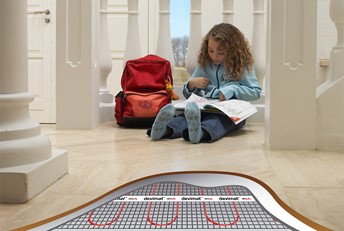
DEVI - THE ULTIMATE CHOICE IN UNDER-FLOOR HEATING
The DEVI underfloor heating system can be used under a variety of floor surfaces and offer an energy-efficient, gentle and lasting warmth. They are a great option for all living and kitchen spaces, bathrooms and entertainment areas.
To download a data sheet on the DEVI Underfloor Heating system, click here
Under-floor Heating with DEVI - Q & A's
I have a floor which is made up of both timber and concrete. Can I use a single heating mat for the floor?
DEVI strongly recommends that each section of floor has its own 'mat' and thermostat as in this instance, each floor surface has a different maximum temperature limit. Contact us to discuss the best options for this floor.
What type of tile adhesive / levelling compound / tiling grout do you recommend?
The covering has to be flexible or have a flexible additive. Talk to your Tiler for advice.
How thick does the layer of tile adhesive/levelling compound need to be?
The adhesive bed has to be thick enough to cover the cables, generally 4-5mm is sufficient.
How long do I have to leave the heating system, after tiling, before I can switch on?
DEVI would recommend that the adhesive used is allowed to dry/cure naturally and to follow manufacturers recommendations.
How long does the heating system take to warm up?
This depends on various factors, such as
- what system has been installed (Undertile or Inslab)?
- the type of screed that has been laid?
- the depth is the floor screed?
- etc.
This Time could be anything from 30 minutes for a Devimat placed under tiles through to 5 - 7 hours for an Inslab storage system.
What is the width of the mat?
The actual width of the mat is 480mm but it is recommended that it be laid at 500mm intervals to ensure the correct gap between runs is achieved.
What is a Single Conductor mat?
With the Single Conductor mat there is a single "cold tail" at each end of the mat and they have to be brought back together at the connection point.
What floor finish is suitable for use with the DEVIMAT system?
Most floor finishes are suitable for use with underfloor heating providing the floor has been prepared correctly and any Manufacturer's temperature guidelines have been adhered to. With finishes such as wood laminates and carpets, it is essential that the heating mat is completely covered with a suitable Floor Leveling Compound before the specified finish is fitted.
The DEVIMAT is too big for the room, can I cut it?
No, the mat Element cannot be shortened as this will alter the resistance of the element which may lead to overheating. It is therefore important that the area to be heated is measured accurately (free floor area only) and that you select the closest smaller area element. Please feel to ask us for help.
Do we require insulation with DEVIMAT products?
The devimat is designed to be laid directly onto an existing floor surface, so does not require insulation. However, if there is room within the floor to add insulation or a tile-backer board we strongly recommend this as it will enhance performance and reduce operating costs. Please contact us for information on Insulation board (FBoard).
Does the floor need to be primed before laying the DEVIMAT?
The mat has an adhesive backing and if the floor is dusty or greasy, it will not stick particularly well. Priming the floor will significantly help the mat to fully adhere to the floor surface.
I want to use DEVIMAT underneath a laminate flooring, what type of underlay do you recommend?
The underlay usually supplied with wood laminate is an acoustic about 2-3mm thick, this is acceptable. If you are installing anything other than this, please call our technical team at DEVI for advice.
Can I put the DEVIMAT underneath a bath / shower tray / kitchen units etc.?
DEVI does not recommend that the devimat is installed under any such fixtures for a number of reasons. eg. (a) It can inhibit the heat being produced from the system. (b) If ever a fault was to occur it would be extremely difficult to carry out a repair etc.












